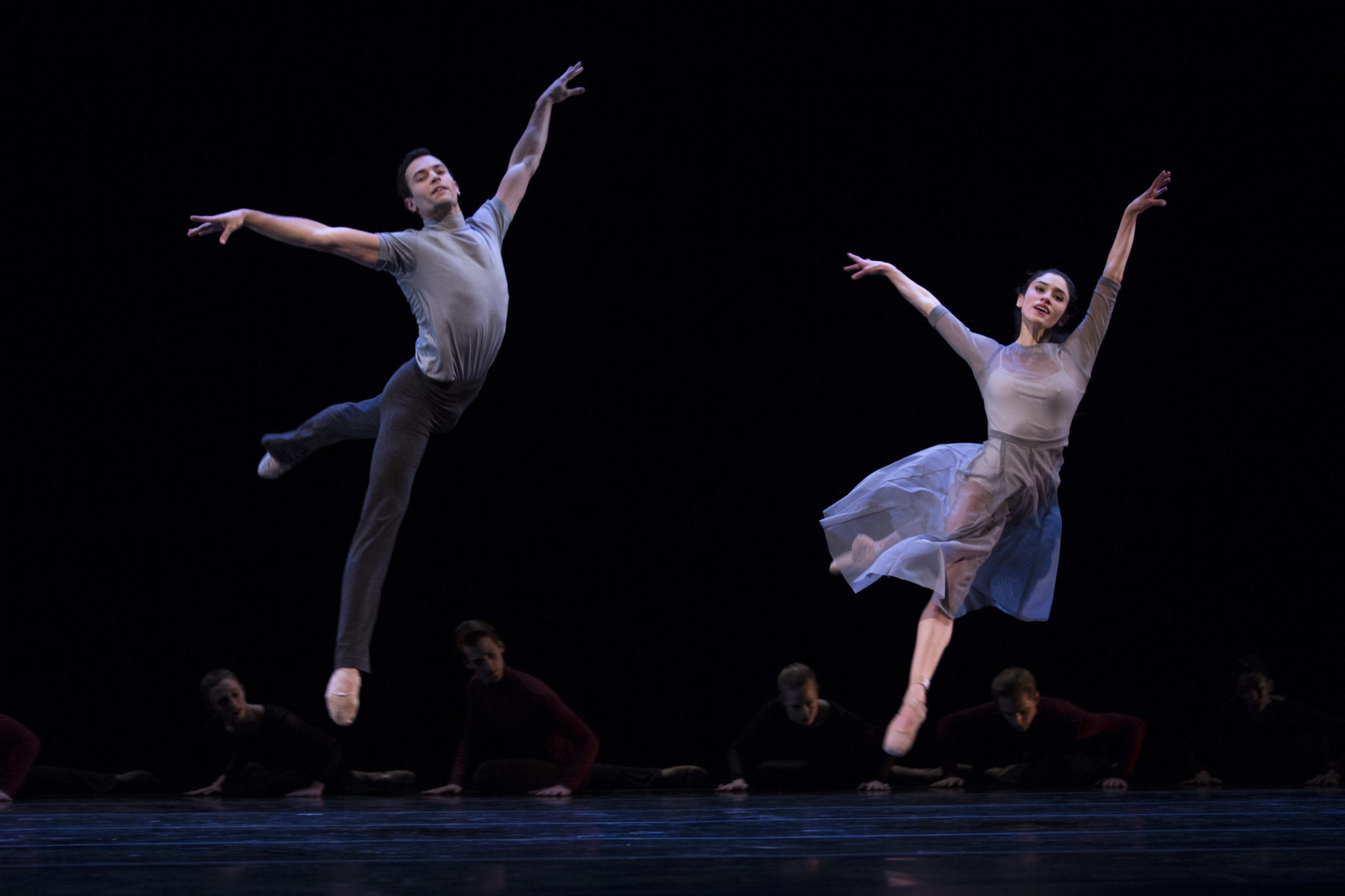Every year, Director’s Choice is my favorite rep at Pacific Northwest Ballet, but this year, Peter Boal knocked it out of the park with his selections. I’ve described Director’s Choice as omakase in the past. Boal himself says he chooses pieces he “wants audiences to understand are worth their attention and exploration.” He has also said that this year, a theme emerged after he chose the four pieces: each piece was choreographed by a dancer who was “given a chance” by their ballet director. The first piece of Director’s Choice, appropriately, was choreographed by one of PNB’s own dancers, Ezra Thomson.
A World Premiere
Thomson is a soloist for Pacific Northwest Ballet. But his long-term goal has been choreography almost since the beginning of his dance career. He has already produced several pieces during his time as a PNB dancer, but “Perpetual State” is his first commission for the main stage. The title of his deeply personal piece, “Perpetual State,” refers to the perpetual states of grief and love established by two major life events that occurred in a relatively short time span: the death of his father and his marriage to fellow dancer Sarah Pasch.
Partway through the performance I realized that I had been nervous about watching choreography from a familiar dancer. (I have never personally met Thomson, although I do follow him on Instagram. I came for the ballet photos and stayed for the metallurgy as he documented the process of making his own wedding rings). It was a lot like when your friend writes a book and you’re scared that it will be hard to find nice things to say if it sucks.
Does it Suck?
Fortunately, “Perpetual State” does not suck. During the pre-talk, Education Programs Manager Doug Fullington talked about Ulysses Dove’s desire to make something new in ballet using Balanchine dancers. This could just as easily be said of “Perpetual State,” which uses the classical ballet vocabulary and movements familiar to PNB audiences, but (to strain a metaphor) his word choice and sentence structure are unique and unexpected. The dancers’ movements combine in unusual ways and create interesting shapes. Actually I thought Thomson’s piece had more visual similarity to the Forsythe that followed it in the program than to the one by Dove. But “Perpetual State” was more soothing and pretty than either of them.
Beauty and Feeling
Supported by Francis Poulanc’s midcentury score, “Perpetual State” chooses emotional resonance over intellectual sophistry or technical challenge. That is to say, the dancers make it look easy; rather than awing the audience with their athleticism, their movements emphasize grace and beauty. This is of course a wise choice for a piece that is specifically about personal experiences and feelings. It’s not the time to redefine ballet.
A Moving Autobiography
Thomson is upfront about the autobiographical nature of his pieces. Fullington even identified the dancer’s roles during the pre-talk. On the night I watched, Leta Biasucci was Thomson’s proxy; Jerome Tisserand was his wife (who is also a PNB dancer). The other pair represented his parents. Karel Cruz’s height appropriately conveys a son’s larger-than-life view of his father; Sarah Ricard Orza his mother. Ryan Cardea got to dance as himself. I would love to interview the dancers and find out what it was like dancing the roles of their own coworkers and friends. But as a viewer, I resisted the urge to take the emotional story too literally. (Maybe I was too successful – I’m not sure I even remembered the casting details correctly).

Pacific Northwest Ballet soloist Leta Biasucci (center), with corps de ballet dancers Sarah-Gabrielle Ryan and Ryan Cardea in Ezra Thomson’s The Perpetual State. 2018. Photo © Angela Sterling.
For one thing, it seemed a little stalkery to try to derive the details of Thomson’s marriage from the movements of dancers on stage. For another, literalism is a boring way to experience dance. It was far more interesting and enjoyable to note the way Thomson used familiar elements in unfamiliar ways. “Perpetual State” ignored the typical groupings that, like courses of a meal, are so formulaic we stop noticing them: corps de ballet then pas de deux etc. His paired dancers shared the stage with each other and with other dancers in interesting combinations that felt as fluid and nonlinear as the emotional story he was telling.
Comfort Food
Other pieces in Director’s Choice (which I will talk about later) were amazing, mind-blowing, challenging the very definition of ballet. In company like that, it might be easy to overlook the relatively comfortable experience of “Perpetual State.” But that doesn’t negate its quality. Like the comfort food that won over the cranky critic in Pixar’s Ratatouille, “Perpetual State” is a satisfying work of art. It seems at home on the Pacific Northwest Ballet stage and I would happily revisit it in future seasons.
Tickets
Tickets ($30-$187) can be purchased online. Subject to availability, tickets are also available 90 minutes prior to each performance at McCaw Hall – these tickets are half-price for students and seniors; $5 for TeenTix members. Remaining performances are:
March 22 – 24 at 7:30 pm
March 25 at 1:00 pm
Just the Facts
The Perpetual State
Music: Francis Poulenc (Concerto for Two Pianos and Orchestra in D minor, FP 61, 1932)
Choreography: Ezra Thomson
Costume Design: Ezra Thomson
Lighting Design: Reed Nakayama
Premiere: March 16, 2018; Pacific Northwest Ballet
Running Time: 22 minutes
Casting on the day I attended:
Leta Biasucci
Jerome Tisserand
Sarah Ricard Orza
Karel Cruz
Sarah-Gabrielle Ryan
Ryan Cardea





About the author